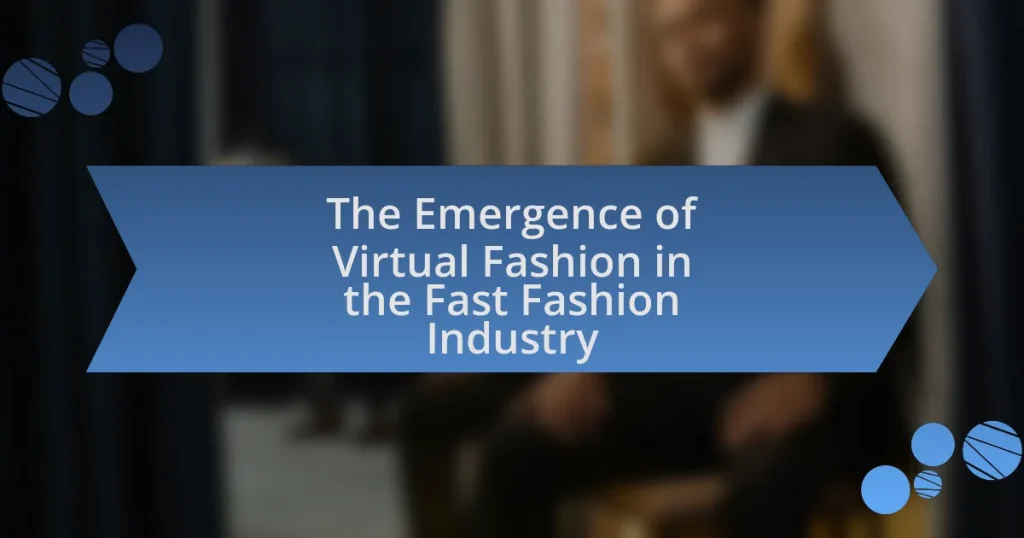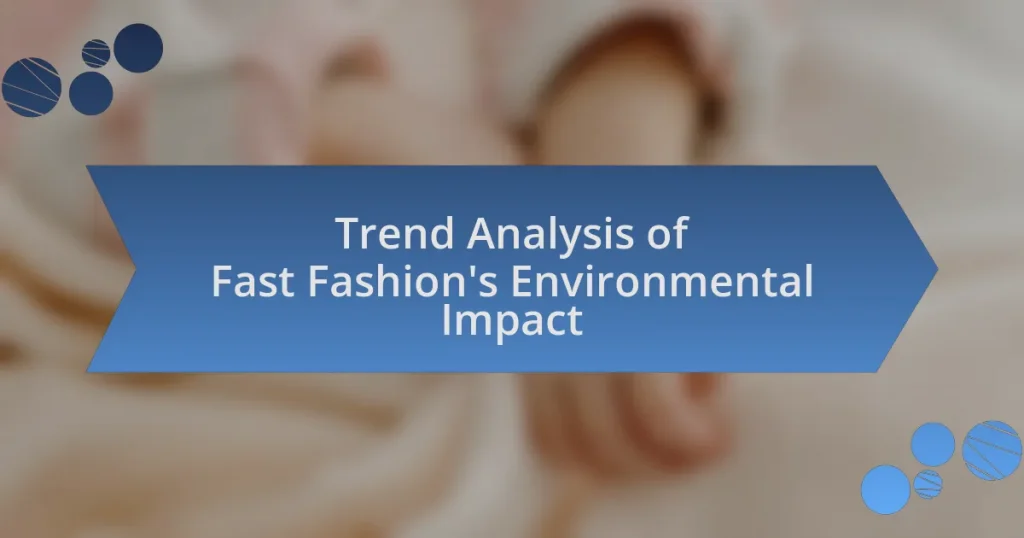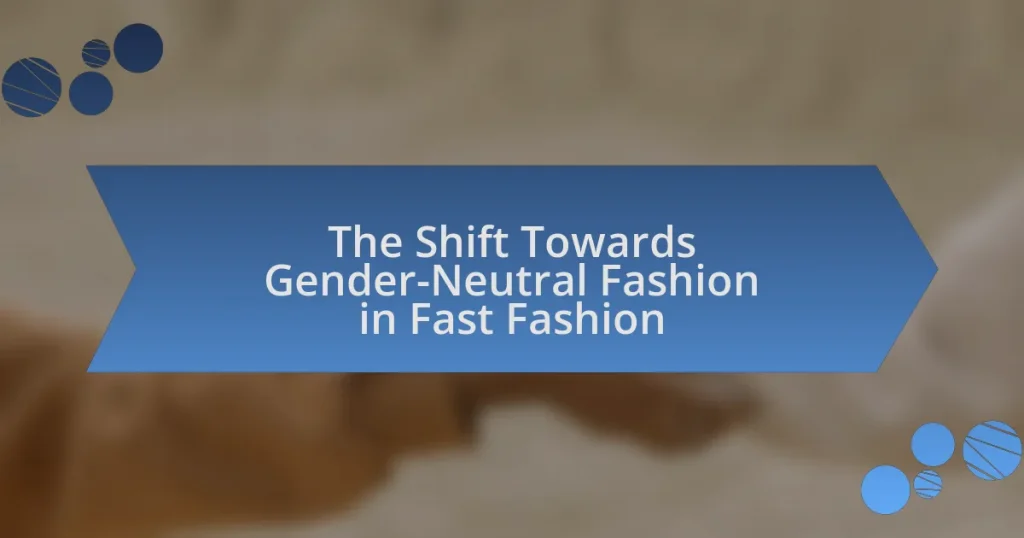The emergence of virtual fashion in the fast fashion industry signifies a transformative shift towards digital clothing and accessories, driven by technological advancements and evolving consumer preferences. Major brands like Balenciaga and Gucci are leading this trend by offering digital-only collections, which not only reduce environmental impact but also cater to the demand for personalized shopping experiences. Key components of this movement include 3D modeling, augmented reality, and artificial intelligence, which enhance consumer engagement and streamline production processes. The article explores the implications of virtual fashion on sustainability, consumer behavior, and the overall landscape of the fashion industry, highlighting both the opportunities and challenges that arise from this innovative approach.
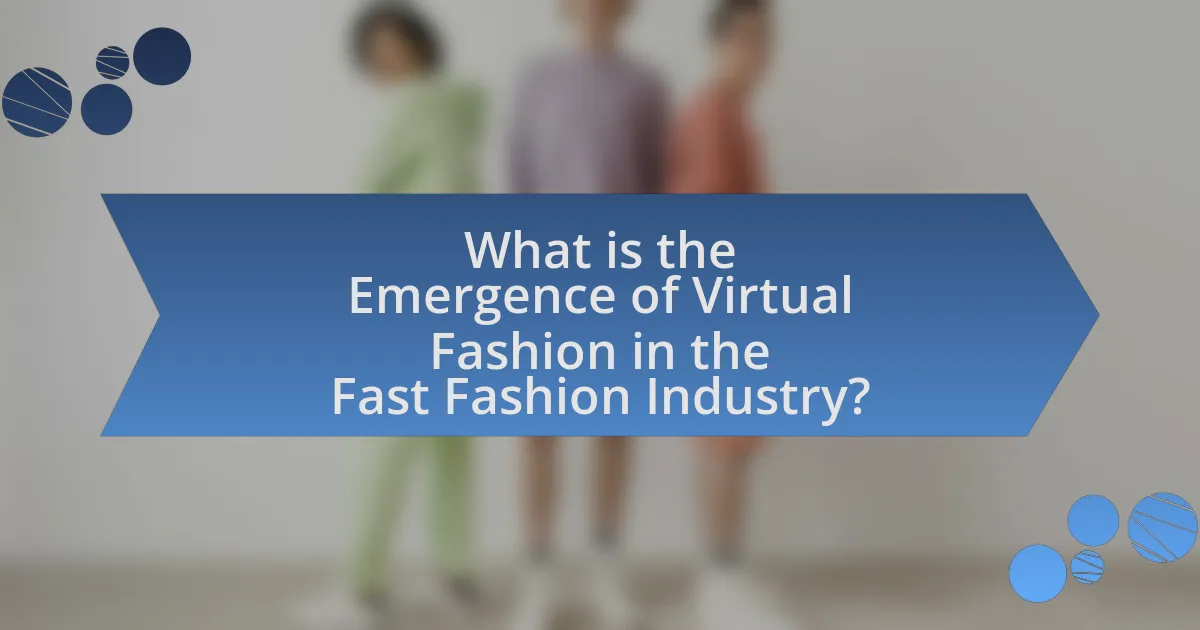
What is the Emergence of Virtual Fashion in the Fast Fashion Industry?
The emergence of virtual fashion in the fast fashion industry refers to the integration of digital clothing and accessories into consumer experiences, driven by advancements in technology and changing consumer behaviors. This trend has gained momentum as brands like Balenciaga and Gucci have begun to create digital-only collections, allowing consumers to purchase and wear virtual garments in online environments, such as social media platforms and virtual reality spaces. According to a report by McKinsey & Company, the global fashion industry is projected to reach $2.5 trillion by 2025, with a significant portion of growth attributed to digital innovations, including virtual fashion. This shift not only reduces the environmental impact associated with traditional fast fashion but also caters to the growing demand for personalized and immersive shopping experiences.
How has virtual fashion changed the landscape of fast fashion?
Virtual fashion has significantly transformed the landscape of fast fashion by introducing digital clothing that eliminates the need for physical production. This shift allows brands to reduce waste and lower costs associated with manufacturing, inventory, and shipping. For instance, companies like The Fabricant and DressX have pioneered the sale of virtual garments, enabling consumers to purchase outfits for online use rather than physical wear. This innovation not only caters to the growing demand for sustainable practices but also aligns with the increasing popularity of digital platforms and social media, where virtual fashion can be showcased without the environmental impact of traditional fast fashion.
What technological advancements have facilitated this change?
Technological advancements such as 3D modeling, augmented reality (AR), and artificial intelligence (AI) have facilitated the emergence of virtual fashion in the fast fashion industry. 3D modeling allows designers to create realistic digital garments, reducing the need for physical samples and enabling rapid prototyping. Augmented reality enhances the shopping experience by allowing consumers to visualize how clothing would look on them through virtual fitting rooms. Artificial intelligence streamlines inventory management and personalizes shopping experiences by analyzing consumer data to predict trends and preferences. These technologies collectively contribute to a more efficient, sustainable, and engaging fashion industry.
How do consumer behaviors influence the rise of virtual fashion?
Consumer behaviors significantly influence the rise of virtual fashion by driving demand for digital experiences and sustainable alternatives. As consumers increasingly prioritize sustainability, they seek options that reduce environmental impact, leading to a growing interest in virtual fashion, which eliminates the need for physical production and waste. Additionally, the rise of social media and online platforms has shifted consumer engagement towards digital interactions, making virtual fashion appealing for its ability to provide unique, customizable experiences that resonate with individual identities. According to a report by McKinsey & Company, 67% of consumers are more likely to purchase from brands that demonstrate a commitment to sustainability, highlighting the direct correlation between consumer preferences and the growth of virtual fashion.
Why is virtual fashion gaining popularity among consumers?
Virtual fashion is gaining popularity among consumers primarily due to its ability to offer unique, customizable experiences that traditional fashion cannot provide. This trend is driven by the increasing integration of technology in daily life, allowing consumers to engage with fashion in immersive ways, such as through augmented reality and virtual try-ons. Additionally, the rise of social media platforms has facilitated the sharing of digital outfits, making virtual fashion a form of self-expression that resonates with younger audiences. According to a report by McKinsey & Company, the global virtual fashion market is projected to grow significantly, reflecting consumer interest in sustainable and innovative fashion solutions.
What are the environmental impacts of virtual fashion compared to traditional fast fashion?
Virtual fashion has significantly lower environmental impacts compared to traditional fast fashion. Traditional fast fashion contributes to substantial waste, with the industry generating over 92 million tons of textile waste annually, and it consumes vast amounts of water and energy in production processes. In contrast, virtual fashion eliminates physical production, reducing resource consumption and waste generation. For instance, a study by the Ellen MacArthur Foundation highlights that digital clothing can reduce carbon emissions by up to 97% compared to physical garments. Additionally, virtual fashion minimizes the use of harmful chemicals and dyes, which are prevalent in traditional manufacturing. Thus, the environmental footprint of virtual fashion is markedly smaller, making it a more sustainable alternative in the fashion industry.
How does virtual fashion cater to the demand for personalization?
Virtual fashion caters to the demand for personalization by allowing consumers to create and customize digital clothing that reflects their individual styles and preferences. This customization is facilitated through advanced technologies such as 3D modeling and augmented reality, enabling users to visualize and modify garments in real-time. For instance, platforms like DressX and The Fabricant offer tools that let users alter colors, patterns, and styles, ensuring that each piece is unique to the wearer. This approach not only enhances user engagement but also aligns with the growing consumer trend towards personalized shopping experiences, as evidenced by a report from McKinsey, which states that 71% of consumers expect personalized interactions.
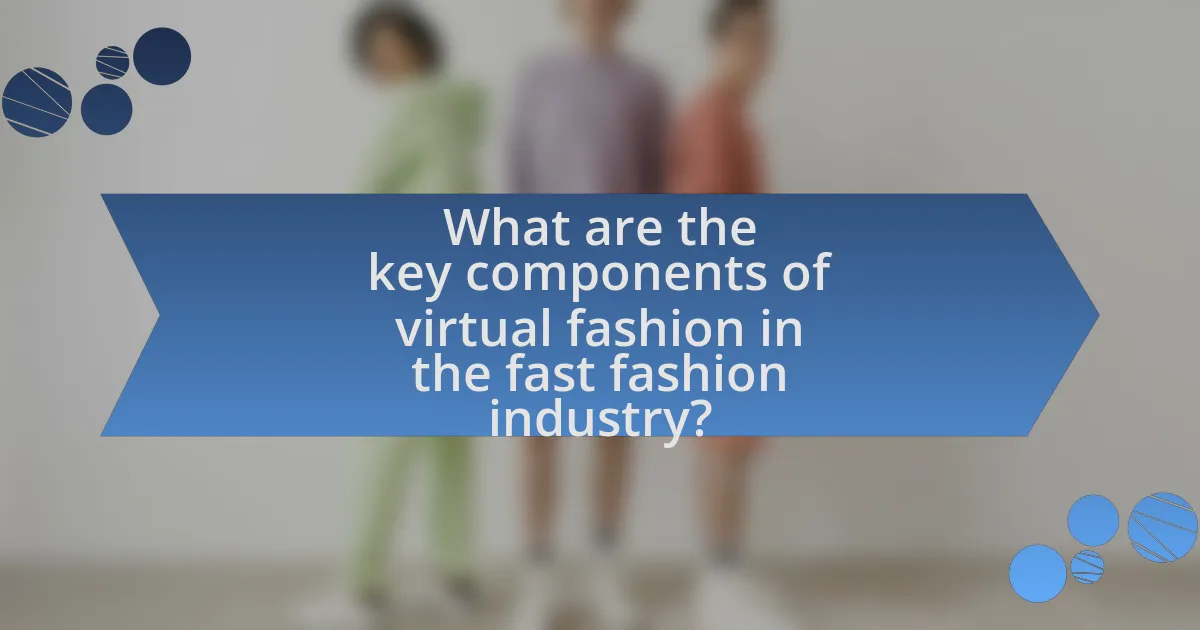
What are the key components of virtual fashion in the fast fashion industry?
The key components of virtual fashion in the fast fashion industry include digital clothing design, augmented reality (AR) fitting rooms, and online marketplaces for virtual garments. Digital clothing design allows brands to create and showcase collections without physical production, reducing waste and costs. Augmented reality fitting rooms enable consumers to visualize how garments would look on them through their devices, enhancing the shopping experience. Online marketplaces facilitate the sale and exchange of virtual clothing, allowing users to purchase and wear digital outfits in virtual environments or social media platforms. These components collectively contribute to a more sustainable and innovative approach within the fast fashion sector.
What technologies are integral to the development of virtual fashion?
The technologies integral to the development of virtual fashion include 3D modeling software, augmented reality (AR), virtual reality (VR), and blockchain technology. 3D modeling software, such as Clo3D and Blender, allows designers to create realistic digital garments, enabling visualization and modification without physical samples. Augmented reality enhances the shopping experience by allowing consumers to try on clothes virtually through applications like Snapchat and Instagram. Virtual reality immerses users in a digital environment where they can interact with fashion items, as seen in platforms like VRChat. Blockchain technology ensures authenticity and traceability of digital fashion items, providing a secure method for ownership and transactions in the virtual space. These technologies collectively facilitate the creation, marketing, and sale of virtual fashion, reflecting the industry’s shift towards digital innovation.
How do augmented reality and virtual reality enhance the shopping experience?
Augmented reality (AR) and virtual reality (VR) significantly enhance the shopping experience by providing immersive and interactive environments that allow consumers to visualize products in real-time. AR enables shoppers to overlay digital images of products onto their physical surroundings, facilitating better decision-making by allowing them to see how items like clothing or furniture would look in their own space. For instance, a study by Deloitte found that 40% of consumers are willing to pay more for a product if they can experience it through AR. VR, on the other hand, creates fully immersive shopping environments where users can explore virtual stores, try on clothes, and interact with products as if they were in a physical store. Research from the International Journal of Retail & Distribution Management indicates that VR can increase customer engagement and satisfaction, leading to higher conversion rates. Together, AR and VR not only enhance product visualization but also create a more engaging and personalized shopping experience, ultimately driving sales in the fast fashion industry.
What role do digital fashion designers play in this industry?
Digital fashion designers play a crucial role in the fast fashion industry by creating virtual clothing and accessories that can be showcased and sold online. They leverage advanced technologies such as 3D modeling and augmented reality to design garments that exist solely in digital form, allowing brands to reduce waste and production costs associated with physical clothing. This innovation enables faster turnaround times for collections, as digital designs can be rapidly produced and modified based on consumer feedback. Additionally, digital fashion designers contribute to the growing trend of virtual fashion shows and online retail experiences, enhancing brand engagement and reaching a broader audience. Their work supports sustainability efforts by minimizing the environmental impact of traditional fashion production methods.
What are the challenges faced by virtual fashion in the fast fashion industry?
Virtual fashion faces several challenges in the fast fashion industry, primarily including sustainability concerns, technological limitations, and consumer acceptance. Sustainability issues arise as virtual fashion, while reducing physical waste, still relies on energy-intensive digital processes and server infrastructures. Technological limitations include the need for advanced software and hardware to create realistic virtual garments, which can be costly and inaccessible for smaller brands. Consumer acceptance is another significant challenge, as many shoppers remain skeptical about the value and practicality of virtual clothing, impacting market penetration. These challenges hinder the widespread adoption and integration of virtual fashion within the fast fashion sector.
How do issues of copyright and ownership affect virtual fashion?
Issues of copyright and ownership significantly impact virtual fashion by determining the legal rights of creators and the use of digital designs. In the virtual fashion industry, designers must navigate copyright laws to protect their original creations from unauthorized reproduction and distribution. For instance, the U.S. Copyright Office recognizes digital fashion designs as eligible for copyright protection, which means that designers can legally enforce their rights against infringers. Additionally, ownership disputes can arise when multiple parties claim rights over a virtual garment, complicating collaborations and sales. The rise of non-fungible tokens (NFTs) has further influenced ownership dynamics, as they provide a method for establishing provenance and ownership of digital assets, thereby enhancing the value and security of virtual fashion items.
What are the barriers to entry for brands looking to adopt virtual fashion?
The barriers to entry for brands looking to adopt virtual fashion include high initial investment costs, technological complexity, and a lack of consumer understanding. High initial investment costs arise from the need for advanced software, skilled personnel, and digital assets creation, which can be financially prohibitive for smaller brands. Technological complexity involves mastering 3D modeling, virtual reality, and augmented reality tools, which require specialized knowledge and training. Additionally, a lack of consumer understanding can hinder adoption, as many consumers are still unfamiliar with virtual fashion concepts, limiting market demand. These factors collectively create significant challenges for brands attempting to enter the virtual fashion space.
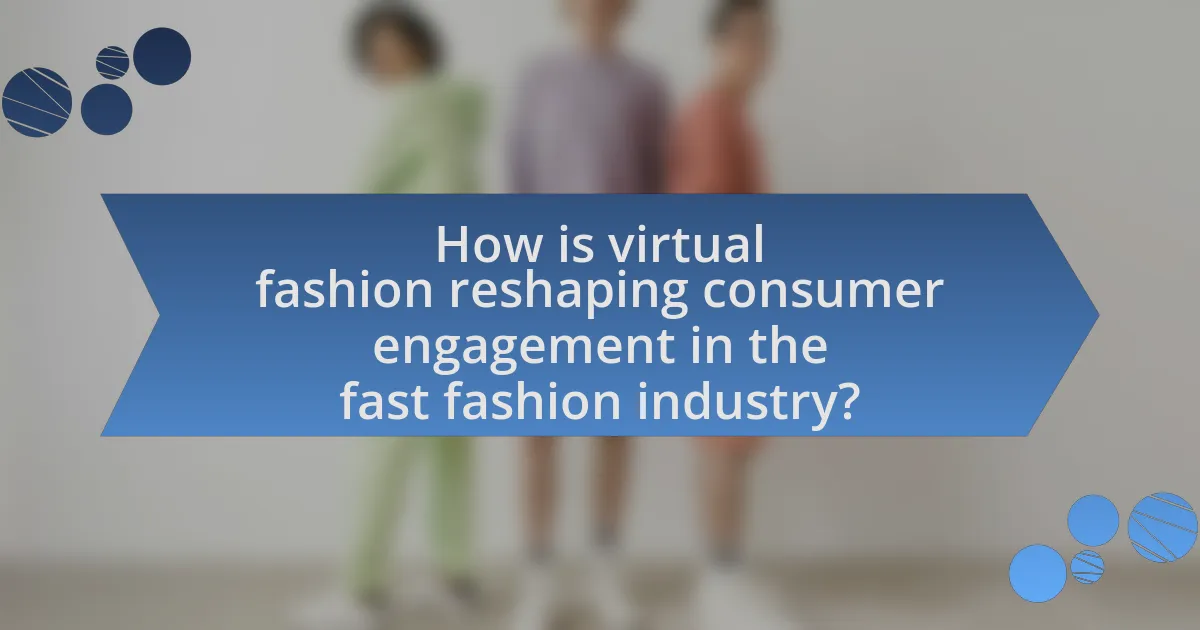
How is virtual fashion reshaping consumer engagement in the fast fashion industry?
Virtual fashion is reshaping consumer engagement in the fast fashion industry by providing immersive and interactive experiences that enhance brand loyalty and personalization. Through technologies like augmented reality (AR) and virtual reality (VR), consumers can try on clothes digitally, which increases their engagement and satisfaction. For instance, a study by McKinsey & Company highlights that brands utilizing AR can see a 40% increase in conversion rates, as customers are more likely to purchase items they can visualize on themselves. This shift not only fosters a deeper connection between consumers and brands but also aligns with the growing demand for sustainable practices, as virtual fashion reduces the need for physical inventory and waste.
What strategies are brands using to market virtual fashion?
Brands are employing several strategies to market virtual fashion, including collaborations with digital influencers, immersive experiences through augmented reality (AR), and leveraging social media platforms for engagement. Collaborations with digital influencers, such as virtual avatars or popular online personalities, help brands reach tech-savvy audiences and create buzz around their virtual collections. Immersive experiences using AR allow consumers to visualize how virtual garments would look on them, enhancing the shopping experience and driving sales. Additionally, brands utilize social media platforms like Instagram and TikTok to showcase virtual fashion through engaging content, which has proven effective in reaching younger demographics who are more inclined to embrace digital trends. These strategies are supported by the growing interest in virtual environments, as evidenced by the increasing number of users in platforms like Roblox and Fortnite, where virtual fashion is becoming a significant aspect of user identity and expression.
How do social media platforms influence the acceptance of virtual fashion?
Social media platforms significantly influence the acceptance of virtual fashion by providing a space for visibility, engagement, and community building around digital clothing. These platforms enable brands and influencers to showcase virtual fashion items, creating trends and driving consumer interest through visually appealing content. For instance, a study by the Journal of Fashion Marketing and Management found that 70% of consumers are influenced by social media when making fashion purchases, highlighting the role of platforms in shaping consumer perceptions and acceptance of new fashion concepts. Additionally, user-generated content and peer validation on social media foster a sense of belonging and acceptance, further promoting the integration of virtual fashion into mainstream culture.
What role do influencers play in promoting virtual fashion trends?
Influencers play a crucial role in promoting virtual fashion trends by leveraging their large followings on social media platforms to showcase and endorse digital clothing and accessories. They create engaging content that highlights virtual fashion items, often collaborating with brands to design exclusive pieces, which drives consumer interest and adoption. For instance, a study by the Fashion Institute of Technology found that influencer marketing can increase brand awareness by up to 11 times, demonstrating the effectiveness of influencers in shaping consumer perceptions and trends in the virtual fashion space.
What future trends can we expect in virtual fashion within the fast fashion industry?
Future trends in virtual fashion within the fast fashion industry include increased integration of augmented reality (AR) and virtual reality (VR) technologies, enabling consumers to try on clothes digitally before purchasing. This trend is supported by the growing popularity of virtual fitting rooms, which enhance the online shopping experience and reduce return rates. Additionally, the rise of digital-only fashion collections, exemplified by brands like Balenciaga and Gucci, indicates a shift towards virtual garments that exist solely in digital spaces, catering to the demand for unique online identities. Furthermore, sustainability will drive the adoption of virtual fashion, as brands seek to minimize waste associated with physical production. According to a report by McKinsey & Company, the digital fashion market is projected to grow significantly, reflecting consumer interest in innovative and sustainable fashion solutions.
How might sustainability initiatives shape the future of virtual fashion?
Sustainability initiatives will significantly shape the future of virtual fashion by promoting eco-friendly practices and reducing waste associated with traditional fashion. As consumers increasingly demand transparency and ethical production, brands are likely to adopt virtual fashion as a means to minimize their environmental footprint. For instance, virtual clothing eliminates the need for physical materials, thereby reducing textile waste and resource consumption. Research indicates that the fashion industry is responsible for 10% of global carbon emissions, highlighting the urgent need for sustainable alternatives. By integrating sustainability into their virtual offerings, brands can appeal to environmentally conscious consumers while also addressing regulatory pressures for greener practices.
What innovations are on the horizon for virtual fashion technology?
Innovations on the horizon for virtual fashion technology include advancements in augmented reality (AR) and artificial intelligence (AI) that enhance user experiences and personalization. AR technology is expected to allow consumers to try on clothes virtually, providing a more immersive shopping experience, while AI algorithms will analyze user preferences to create customized fashion recommendations. Additionally, the integration of blockchain technology is anticipated to improve transparency in supply chains and ensure authenticity in digital fashion items. These innovations are supported by the growing investment in virtual fashion startups, which reached over $1 billion in 2022, indicating a robust market potential for these technologies.
What best practices should brands consider when integrating virtual fashion?
Brands should prioritize user engagement and authenticity when integrating virtual fashion. Engaging users through interactive experiences, such as virtual try-ons and gamified shopping, enhances customer connection and satisfaction. Authenticity is crucial; brands must ensure that virtual representations align with their physical products to maintain trust. According to a report by McKinsey, 70% of consumers value authenticity in brand communications, indicating that brands should focus on transparent storytelling and ethical practices in their virtual fashion initiatives. Additionally, leveraging data analytics to understand consumer preferences can guide brands in creating tailored virtual fashion experiences that resonate with their target audience.
How can brands effectively balance virtual and physical fashion offerings?
Brands can effectively balance virtual and physical fashion offerings by integrating digital experiences with tangible products. This integration can be achieved through strategies such as offering virtual try-ons, which enhance customer engagement and reduce return rates; for instance, a study by the National Retail Federation found that virtual fitting rooms can decrease return rates by up to 30%. Additionally, brands can create exclusive virtual collections that complement their physical lines, driving interest and sales in both realms. By leveraging data analytics, brands can understand consumer preferences and optimize inventory management, ensuring that both virtual and physical offerings meet market demand. This dual approach not only enhances customer experience but also maximizes revenue potential across both platforms.
What are the key metrics for measuring success in virtual fashion initiatives?
Key metrics for measuring success in virtual fashion initiatives include engagement rates, conversion rates, customer retention, and brand awareness. Engagement rates assess how users interact with virtual fashion content, such as likes, shares, and comments, indicating interest and reach. Conversion rates measure the percentage of users who make a purchase after engaging with virtual fashion, reflecting the effectiveness of marketing strategies. Customer retention tracks repeat purchases and loyalty, showing how well the initiative fosters ongoing relationships with consumers. Brand awareness is evaluated through metrics like social media mentions and search volume, indicating the initiative’s impact on brand visibility. These metrics collectively provide a comprehensive view of the initiative’s performance and its alignment with business objectives.










